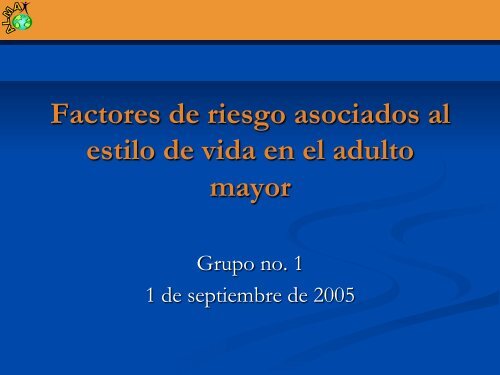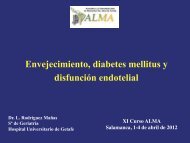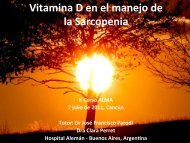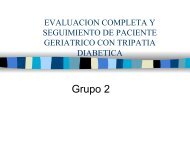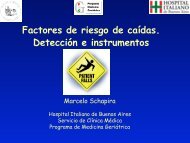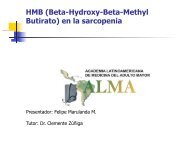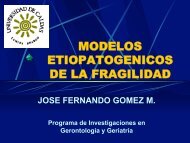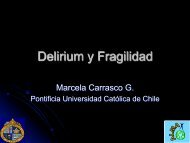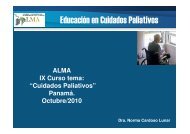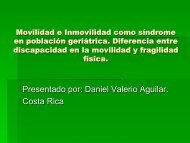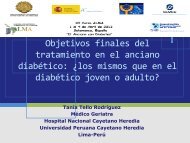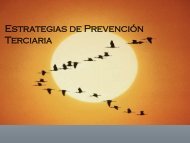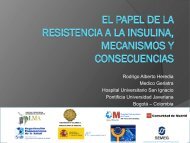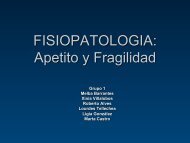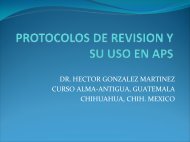Factores de riesgo asociados al estilo de vida en el adulto mayor
Factores de riesgo asociados al estilo de vida en el adulto mayor
Factores de riesgo asociados al estilo de vida en el adulto mayor
Create successful ePaper yourself
Turn your PDF publications into a flip-book with our unique Google optimized e-Paper software.
<strong>Factores</strong> <strong>de</strong> <strong>riesgo</strong> <strong>asociados</strong> <strong>al</strong><br />
<strong>estilo</strong> <strong>de</strong> <strong>vida</strong> <strong>en</strong> <strong>el</strong> <strong>adulto</strong><br />
<strong>mayor</strong><br />
Grupo no. 1<br />
1 <strong>de</strong> septiembre <strong>de</strong> 2005
<strong>Factores</strong> <strong>de</strong> <strong>riesgo</strong> <strong>al</strong> <strong>estilo</strong> <strong>de</strong> <strong>vida</strong> <strong>en</strong> <strong>el</strong> AM<br />
Factor <strong>de</strong> <strong>riesgo</strong><br />
n Es aqu<strong>el</strong> ev<strong>en</strong>to que increm<strong>en</strong>ta la<br />
probabilidad <strong>de</strong> <strong>en</strong>fermarse cuando<br />
se expone a él.
<strong>Factores</strong> <strong>de</strong> <strong>riesgo</strong> <strong>al</strong> <strong>estilo</strong> <strong>de</strong> <strong>vida</strong> <strong>en</strong> <strong>el</strong> AM<br />
Niv<strong>el</strong>es <strong>de</strong> prev<strong>en</strong>ción<br />
n Primaria<br />
n Secundaria<br />
n Terciaria
<strong>Factores</strong> <strong>de</strong> <strong>riesgo</strong> <strong>al</strong> <strong>estilo</strong> <strong>de</strong> <strong>vida</strong> <strong>en</strong> <strong>el</strong> AM<br />
Detección <strong>de</strong> factores<br />
n V<strong>al</strong>oración Geriátrica
<strong>Factores</strong> <strong>de</strong> <strong>riesgo</strong> <strong>al</strong> <strong>estilo</strong> <strong>de</strong> <strong>vida</strong> <strong>en</strong> <strong>el</strong> AM<br />
Tabaquismo<br />
n Epi<strong>de</strong>miológicam<strong>en</strong>te factor negativo<br />
n AM >65 años 10 %<br />
n Dobla mort<strong>al</strong>idad <strong>de</strong> IM, EVC,<br />
n B<strong>en</strong>eficio <strong>en</strong> prev<strong>en</strong>ción Primaria y secundaria:<br />
Cardiopulmonar<br />
n Princip<strong>al</strong> efecto:<br />
n Pulmonar<br />
n Al <strong>de</strong>jar <strong>de</strong> fumar se regresa a niv<strong>el</strong>es <strong>de</strong><br />
mort<strong>al</strong>idad previas, <strong>de</strong>s<strong>de</strong> <strong>el</strong> primer año.
<strong>Factores</strong> <strong>de</strong> <strong>riesgo</strong> <strong>al</strong> <strong>estilo</strong> <strong>de</strong> <strong>vida</strong> <strong>en</strong> <strong>el</strong> AM<br />
Ejercicio
<strong>Factores</strong> <strong>de</strong> <strong>riesgo</strong> <strong>al</strong> <strong>estilo</strong> <strong>de</strong> <strong>vida</strong> <strong>en</strong> <strong>el</strong> AM<br />
AFP, Abril 2002
<strong>Factores</strong> <strong>de</strong> <strong>riesgo</strong> <strong>al</strong> <strong>estilo</strong> <strong>de</strong> <strong>vida</strong> <strong>en</strong> <strong>el</strong> AM
<strong>Factores</strong> <strong>de</strong> <strong>riesgo</strong> <strong>al</strong> <strong>estilo</strong> <strong>de</strong> <strong>vida</strong> <strong>en</strong> <strong>el</strong> AM<br />
Clinic<strong>al</strong> Geriatrics, Apr 2005
<strong>Factores</strong> <strong>de</strong> <strong>riesgo</strong> <strong>al</strong> <strong>estilo</strong> <strong>de</strong> <strong>vida</strong> <strong>en</strong> <strong>el</strong> AM<br />
Ejercicio<br />
n Mejora parámetros clínicos<br />
n Individu<strong>al</strong>izar programa física <strong>en</strong> base a<br />
condición física, comorbilida<strong>de</strong>s, c<strong>al</strong>idad <strong>de</strong> <strong>vida</strong><br />
n Programa <strong>de</strong> ejercicio (aérobico, resist<strong>en</strong>cia,<br />
flexibilidad y b<strong>al</strong>ance) y <strong>de</strong> ser posible, incluirlo,<br />
<strong>en</strong> las acti<strong>vida</strong><strong>de</strong>s <strong>de</strong> la <strong>vida</strong> diaria<br />
n Movilidad como factor <strong>de</strong> fragilidad
<strong>Factores</strong> <strong>de</strong> <strong>riesgo</strong> <strong>al</strong> <strong>estilo</strong> <strong>de</strong> <strong>vida</strong> <strong>en</strong> <strong>el</strong> AM<br />
Nutrición<br />
n La m<strong>al</strong>a nutrición per se induce otros factores <strong>de</strong><br />
<strong>riesgo</strong><br />
n Aum<strong>en</strong>ta todos los aspectos <strong>de</strong> morbimort<strong>al</strong>idad<br />
n Es <strong>el</strong> primero <strong>en</strong> aparecer
<strong>Factores</strong> <strong>de</strong> <strong>riesgo</strong> <strong>al</strong> <strong>estilo</strong> <strong>de</strong> <strong>vida</strong> <strong>en</strong> <strong>el</strong> AM<br />
Nutrición<br />
Nutri<strong>en</strong>te<br />
Grasas saturadas<br />
Grasas poli-insaturadas<br />
Grasas monosaturadas<br />
Grasa tot<strong>al</strong><br />
Carbohidratos<br />
Fibra<br />
Proteina<br />
Colesterol<br />
Energia tot<strong>al</strong> (c<strong>al</strong>orías)<br />
Recom<strong>en</strong>dación<br />
< 7 % <strong>de</strong>l tot<strong>al</strong> <strong>de</strong> c<strong>al</strong>orías<br />
Hasta <strong>el</strong> 10 % <strong>de</strong>l tot<strong>al</strong> <strong>de</strong> c<strong>al</strong>orías<br />
Hasta <strong>el</strong> 20 % <strong>de</strong>l tot<strong>al</strong> <strong>de</strong> c<strong>al</strong>orías<br />
20 – 35 % <strong>de</strong>l tot<strong>al</strong> <strong>de</strong> c<strong>al</strong>orías<br />
50 – 60 % <strong>de</strong>l tot<strong>al</strong> <strong>de</strong> c<strong>al</strong>orías<br />
25 – 30 g/día<br />
Aprox. 15 % <strong>de</strong>l tot<strong>al</strong> <strong>de</strong> c<strong>al</strong>orías<br />
< 200 mg/d<br />
B<strong>al</strong>ance <strong>en</strong>tre ingreso y metabolismo mant<strong>en</strong>i<strong>en</strong>do<br />
peso i<strong>de</strong><strong>al</strong>, evitando aum<strong>en</strong>to <strong>de</strong>l mismo
<strong>Factores</strong> <strong>de</strong> <strong>riesgo</strong> <strong>al</strong> <strong>estilo</strong> <strong>de</strong> <strong>vida</strong> <strong>en</strong> <strong>el</strong> AM<br />
Alcohol<br />
n La r<strong>el</strong>ación <strong>en</strong>tre <strong>al</strong>cohol y mort<strong>al</strong>ida<br />
cardiovascular <strong>de</strong>scribe una gráfica <strong>en</strong> U.<br />
n La difer<strong>en</strong>cia <strong>en</strong>tre <strong>el</strong> <strong>al</strong>cohólico y no <strong>en</strong> la<br />
presión arteri<strong>al</strong> es <strong>de</strong> 5 a 10 mmHg <strong>en</strong> la sistólica<br />
y <strong>de</strong> 3 a 6 <strong>en</strong> la diastólica.<br />
n No se sabe <strong>el</strong> tiempo para obt<strong>en</strong>er <strong>el</strong> b<strong>en</strong>eficio a<br />
bajas cantida<strong>de</strong>s.
<strong>Factores</strong> <strong>de</strong> <strong>riesgo</strong> <strong>al</strong> <strong>estilo</strong> <strong>de</strong> <strong>vida</strong> <strong>en</strong> <strong>el</strong> AM<br />
“Don´t Worry, Be Happy”<br />
n Esc<strong>al</strong>a Optimismo-Pesimismo (<strong>de</strong> MMPI) +<br />
SF-36<br />
n 447 paci<strong>en</strong>tes a través <strong>de</strong> 30 años<br />
n 16.6% optimistas, 60.8% mixto y 22.6%<br />
pesimistas<br />
n Optimistas: Viv<strong>en</strong> más (P>0.002) y <strong>en</strong> mejores<br />
condiciones <strong>de</strong> s<strong>al</strong>ud<br />
Mayo Clin Proc 2002; 77 (August): 748-753
Ejemplo <strong>de</strong> conclusión
<strong>Factores</strong> <strong>de</strong> <strong>riesgo</strong> <strong>al</strong> <strong>estilo</strong> <strong>de</strong> <strong>vida</strong> <strong>en</strong> <strong>el</strong> AM<br />
Cambios <strong>en</strong> <strong>el</strong> <strong>estilo</strong> <strong>de</strong> <strong>vida</strong> para <strong>el</strong> manejo <strong>de</strong> la hipert<strong>en</strong>sión<br />
MODIFICACIÓN *<br />
Reducción <strong>de</strong>l<br />
peso<br />
Adoptar <strong>el</strong> plan<br />
<strong>de</strong> comer DASH<br />
Reducción <strong>de</strong>l<br />
sodio <strong>en</strong> la dieta<br />
Acti<strong>vida</strong>d física<br />
Tomar <strong>al</strong>cohol<br />
con mo<strong>de</strong>ración<br />
RECOMENDACIÓN<br />
Mant<strong>en</strong>er un peso norm<strong>al</strong> (IMC 18.5–24.9 kg/m 2 )<br />
Consumir una dieta rica <strong>en</strong> frutas, veget<strong>al</strong>es y<br />
productos bajos <strong>en</strong> grasas con cont<strong>en</strong>idos bajos <strong>de</strong><br />
grasa tot<strong>al</strong> y saturada.<br />
Reducir <strong>el</strong> sodio o no más <strong>de</strong> 100 mmol por día<br />
(2.4 g <strong>de</strong> sodio o 6 g s<strong>al</strong>).<br />
Estimular una acti<strong>vida</strong>d física aeróbica como <strong>el</strong><br />
caminar (por lo m<strong>en</strong>os 30 minutos por día casi<br />
todos los días <strong>de</strong> la semana).<br />
Limitar <strong>el</strong> consumo diario a no más <strong>de</strong> dos copas<br />
(30 mL etanol; ejemplos:720 mL cerveza, 300 mL<br />
vino, o 90 mL whisky) para los hombres y una<br />
copa por día para las mujeres y las personas <strong>de</strong> bajo<br />
peso.<br />
DASH, Dietary Approaches to Stop Hypert<strong>en</strong>sion.<br />
REDUCCIÓN APROXIMADA<br />
PS (RANGO)<br />
5–20 mmHg/10 kg<br />
<strong>de</strong> pérdida <strong>de</strong> peso<br />
8–14 mmHg<br />
2–8 mmHg<br />
4–9 mmHg<br />
2–4 mmHg<br />
JNC 7, mayo 2003
<strong>Factores</strong> <strong>de</strong> <strong>riesgo</strong> <strong>al</strong> <strong>estilo</strong> <strong>de</strong> <strong>vida</strong> <strong>en</strong> <strong>el</strong> AM<br />
M<strong>en</strong>saje fin<strong>al</strong><br />
n No buscar un punto <strong>de</strong> corte.<br />
n Todo es ganancia<br />
n El pap<strong>el</strong> <strong>de</strong>l equipo <strong>de</strong> s<strong>al</strong>ud para<br />
incidir <strong>en</strong> los cambios es<br />
primordi<strong>al</strong>.


